Arugula, Eruca vesicaria, is a leafy salad green in the Brassicaceae family that also includes broccoli, cabbage, cauliflower, kale, and Swiss chard.
It’s a self-seeding annual for Zones 3 to 11 that thrives in full sun and well-draining soil. You may know arugula as “rocket” or “rucola,” and appreciate its zesty, peppery tang.
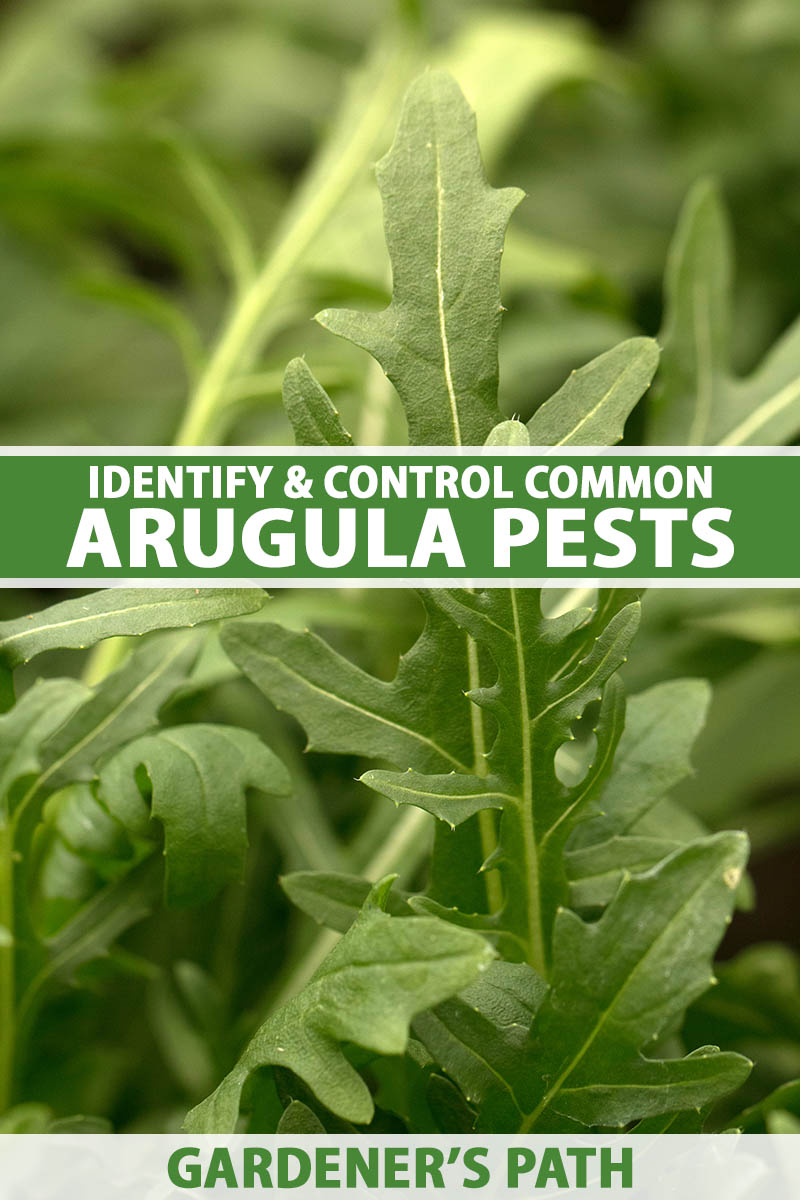
We link to vendors to help you find relevant products. If you buy from one of our links, we may earn a commission.
In our guide to growing arugula we discuss all you need to know to cultivate it yourself.
This article zeroes in on recognizing and managing 15 common arugula insect pests.
Here’s the lineup:
The best defense against insect pests is cultivating healthy plants.
Start with quality seed or seedlings, and avoid under- and overwatering which can render your arugula vulnerable to attack.
Proactive measures to inhibit pest infestation include:
- Purchasing quality seed and transplants from reputable purveyors.
- Rotating brassica crops to new locations every year.
- Growing your crop under floating row covers.
- Planting trap crops, such as radishes, around your arugula plants to draw pests away.
- Sowing companion plants, like flowering caraway, coneflowers, dill, fennel, sweet clover, and yarrow, to attract beneficial insects that feed on pests.
- Installing and filling songbird feeders to attract small birds to prey upon insect pests. Avoid attracting large birds because they may feed on the arugula plants.
- Clearing all garden debris and disposing of it at season’s end to inhibit nuisance insects from overwintering.
When you notice pests early, it’s often possible to head off a full-blown infestation by a combination of handpicking them, spraying them away with the hose, or pinching off individual affected leaves and discarding them.
However, sometimes there are too many, and treatment with food-safe insecticides is the best course of action.
Note that some treatments may kill beneficial insects, too. Weigh the pros and cons of various methods for addressing pests before application.
In addition to damaging plants by feeding, some of these unwanted visitors may be vectors of disease, which multiplies their potential for widespread damage in the garden.
The following insect pests recognize arugula as a host plant:
1. Aphids
Aphids are sapsuckers that chew foliage and inject plant-toxic saliva as they feed. The result is foliar disfigurement, stunting, desiccation, and trails of sticky “honeydew” on the surface of the leaves.
They often appear in large colonies that obscure the foliage beneath them.
There are three main species that attack arugula crops:
The cabbage aphid, Brevicoryne brassicae, is distinguished from other types of aphid by its waxy grayish-white coating and two rear protruding appendages called cornicles that are shorter than most other species.
Adults measure two to two and a half millimeters long.

Females produce live young or lay eggs on the undersides of arugula and other brassica leaves. The eggs are green to yellow and mature to black before hatching. Cabbage aphid populations increase in cool weather.
The green peach aphid, Myzus persicae, is yellowish-green with no waxy coating and has the typical long cornicles of most aphid species.
Adults measure approximately two millimeters long. Females lay green or yellow eggs on the bark of fruit trees in the Prunus genus, and once the young nymphs grow their adult wings, they fly to host plants like arugula to feed.
And the potato aphid, Macrosiphum euphorbiae, is pink or grayish-green and measures two to four millimeters long at maturity. The first generation hatches from the typical yellow to green egg that deepens to black, and successive generations may be live-born.
One method of prevention is to use reflective mulch around your plants to make it hard for aphids to locate the arugula.
Natural remedies include:
- Handpicking insects and pruning affected foliage.
- Spraying with a steady stream of water.
- Dousing with mild dish detergent soapsuds.
- Applying food-grade diatomaceous earth to the foliage and the soil around your plants.
- Treating with neem oil.
Neem oil is a readily available naturally-sourced insecticide made from the seeds of the neem tree, aka Indian lilac, Azadirachta indica.
Captain Jack’s neem oil from Bonide is safe to use on edible plants. It comes in a 32-ounce ready-to-spray bottle.
Captain Jack’s neem oil is available from Bonide via Amazon. Apply according to package instructions.
Diatomaceous earth is made from crushed fossils and is suitable for use on food crops.
Bonide diatomaceous earth is available from Gardener’s Supply Company in one-and-a-half-pound shaker jugs.
Learn more about how to use diatomaceous earth in our guide.
See our guide for more information on controlling and eradicating aphids.
2. Armyworms
The beet armyworm, Spodoptera exigua, and southern armyworm, Spodoptera eridania, are caterpillars typically found in southern regions that may be a variety of colors, depending upon their stage of development, or “instar.”
Armyworms are the larvae of night-flying owlet moths in the Noctuidae family.
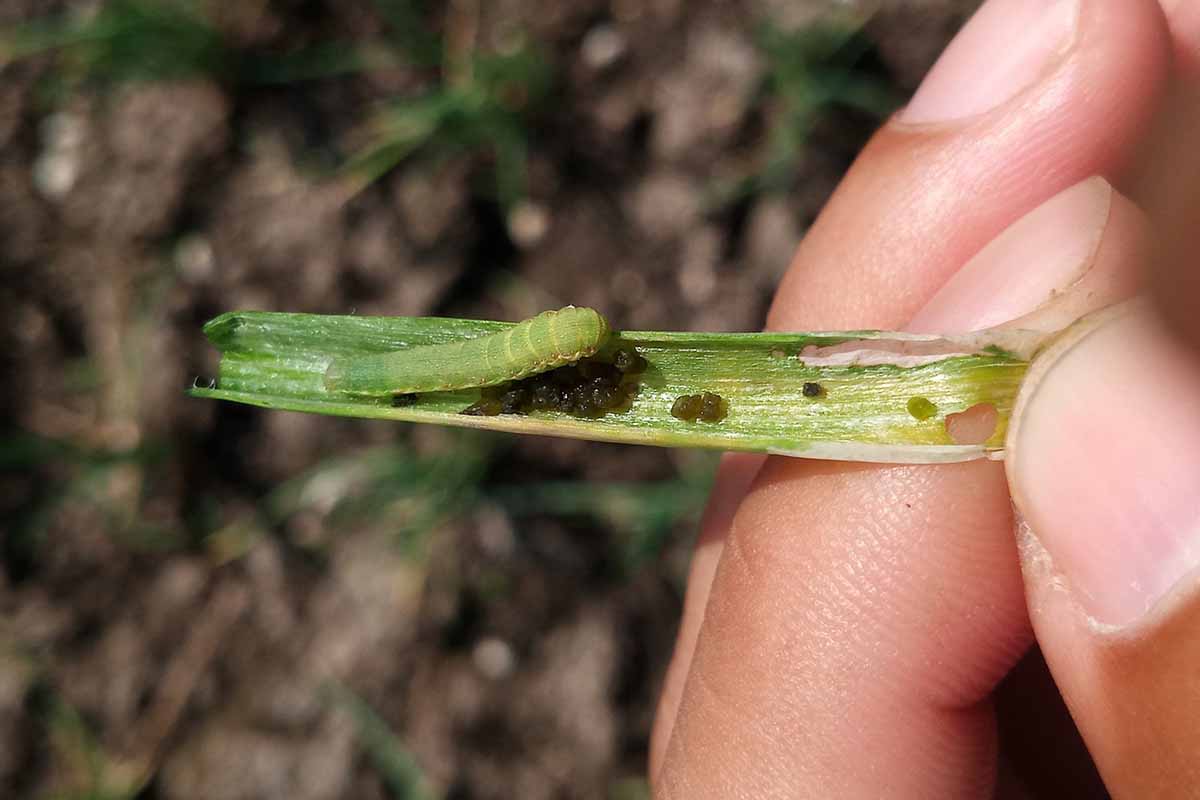
Adult female moths of both species lay greenish eggs covered in white, cottony scales.
After hatching, voracious caterpillars eat the tissue between the leaf veins, leaving them skeletonized. These pests are prevalent late in the season, and in warm regions they overwinter in plant debris.
The youngest caterpillars are pale green or yellow with blackish heads. Older ones are green with a yellow stripe and black marking on each side near the first true legs.
Later instars may be a combination of green and pink with white stripes and black dots, and measure up to an inch and a half long.
Natural predators include beneficial parasitic wasps and tachinid flies. Weeding around your arugula is essential, as eggs and caterpillars commonly migrate from host weeds, like lamb’s quarters and pigweed.
Organic Bacillus thuringiensis, commonly known as Bt, is a natural pesticide made from soilborne bacteria that is often an effective treatment for an infestation. It is safe for use on edible crops.

Bonide Captain Jack Bacillus thuringiensis
Bonide’s Captain Jack Bacillus thuringiensis comes in a 32-ounce ready-to-spray bottle, available via Amazon.
You can read about Bt and how to use it in our guide.
Using pheromone traps to catch adult moths and inhibit mating may also be effective.
Scentry Lures attract and capture adult moths by combining a mating hormone scent with a sticky trap. This effectively traps the adults and prevents them from reproducing.
Scentry Lures are available from Arbico Organics in packages containing five or 10.
3. Cabbage Loopers
The cabbage looper is the larva of a grayish-brown owlet moth, Trichoplusia ni, that lays green to yellowish eggs on the undersides of arugula foliage.
It is a green inchworm with a white stripe running down the side of its body, and measures one to one and a half inches long.
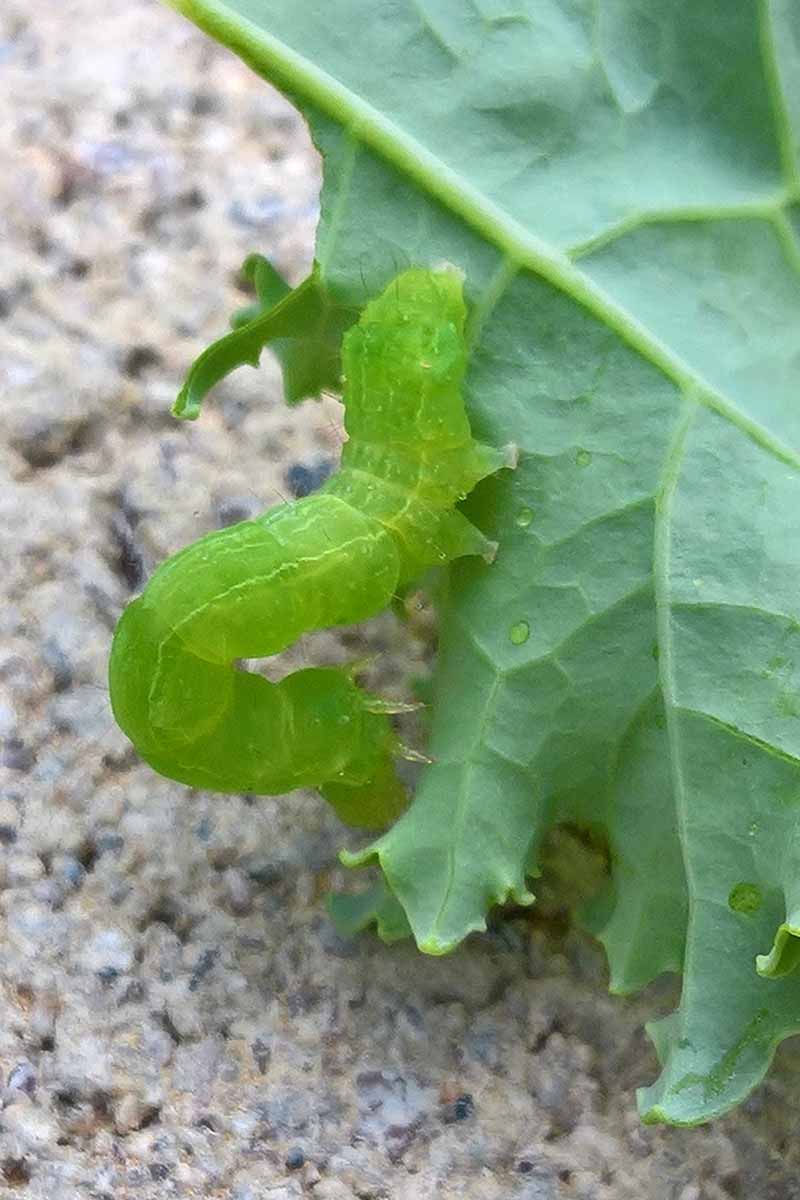
The first sign of damage may be thin, almost translucent areas in the arugula leaves, the mark of feeding from the undersides of the foliage.
If left unchecked, the damage progresses to large, irregular holes in the foliage, and the consumption of entire leaves.
Naturally-sourced treatments include:
- Applying food-grade diatomaceous earth.
- Introducing beneficial insects, such as predatory wasps (Trichogramma spp.) and green lacewings (Chrysoperla rufilabris).
- Treating with Bt.
- Applying an insecticide containing pyrethrins.
Pyrethrins are naturally-derived insecticides often sourced from chrysanthemums.
PyGanic Gardening is a botanical insecticide that contains natural pyrethrin sourced from daisies.
PyGanic Gardening is available from Arbico Organics in eight-, 32-, and 128-ounce bottles of liquid concentrate to mix with water. Apply to the foliage according to package instructions.
See our guide to managing cabbage loopers for more information.
4. Crickets
Crickets, Acheta domesticus, can be a curse and a blessing. Yes, they may munch on your leafy greens. However, they also eat aphids and weed seeds and excrete waste that fertilizes the garden.
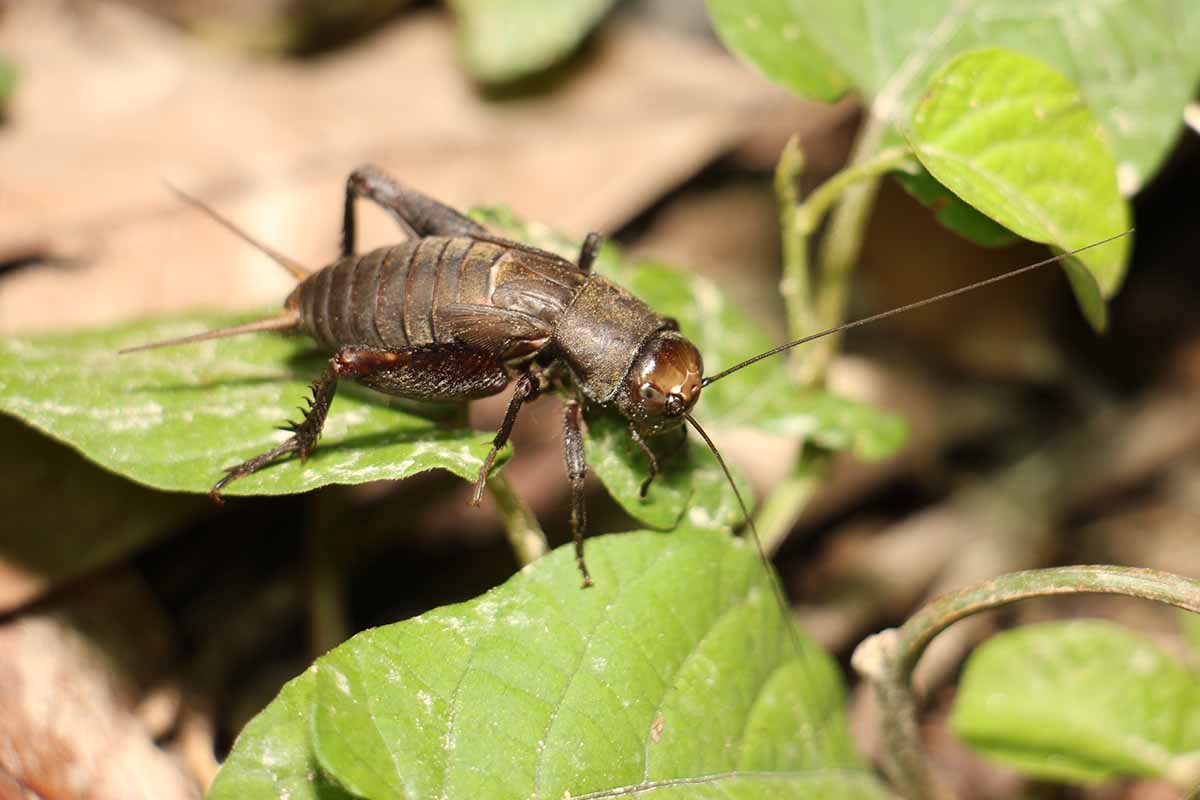
Crickets like damp areas and dense growth. Avoid overwatering and overcrowding to inhibit moisture buildup.
Weed the garden regularly to deprive them of habitat.
Heavy infestation may warrant the use of food-grade diatomaceous earth.
5. Cutworms
Cutworms, like armyworms, are the larvae of owlet moths in the Noctuidae family. There are numerous species, but it’s the black cutworm, Agrotis ipsilon, that feeds on arugula and other brassicas.

What best distinguishes cutworms from armyworms is their feeding behavior.
Armyworms commonly feed in groups and skeletonize leaves with their voracious chewing. Cutworms feed individually, severing new shoots at the soil level.
Adult female moths lay white eggs in garden debris and weeds. The eggs darken as they mature.
The caterpillars are gray to black with dark brown heads, a lighter band on top, and a lighter underside. They tend to curl up into a C-shape when touched or disturbed.
Natural predators include beneficial syrphid flies, parasitic wasps, and beneficial nematodes.
Bats and birds are also helpful allies in battling cutworms. Consider installing birdhouses and bat houses in your yard to enlist their aid.
Because cutworms can overwinter on dead plant tissue, it’s crucial to clear debris at season’s end and rotate crops regularly. Tilling in the spring can help bring cutworms to the surface of the soil for predators to feed upon.
If you notice them on your arugula, handpick the caterpillars and remove affected foliage.
Naturally-sourced treatments include pheromone lures that target adult moths, food-grade diatomaceous earth, and spraying with Bt.
See our guide to cutworms for more information.
6. Diamondback Moth Caterpillars
The larvae of the diamondback moth, aka cabbage moth, Plutella xylostella, are caterpillars that are light green with black heads, random black hairs, and tapered ends.
They measure approximately nine and a half millimeters long.

The adult moths are brownish. When the wings are folded, the male has fairly prominent yellow to white diamond shapes on its back. Female coloration is less pronounced.
Pale yellow eggs hatch on the undersides of the arugula foliage, then the larvae burrow through the plant tissue before emerging as full-grown caterpillars to feed on top of it.
Signs of damage include “windowpaning” by young larvae that chew from below and leave a thin layer of plant tissue. Older larvae chew holes in the foliage and new shoots.
Adults winter over in brassica debris if it is not removed post-harvest.
This species is resistant to most pesticides, including Bt, and may be hard to eradicate.
The best method is to handpick caterpillars and destroy them.
Clear all garden debris at season’s end and always rotate your brassica crops to avoid this pest.
7. Flea Beetles
The adult crucifer flea beetle, Phyllotreta cruciferae, is a tiny, bluish-black or green, hard-shelled beetle measuring two to three millimeters long.
It has a habit of “shot-holing” or chewing rounded holes straight through the leaves of your arugula.
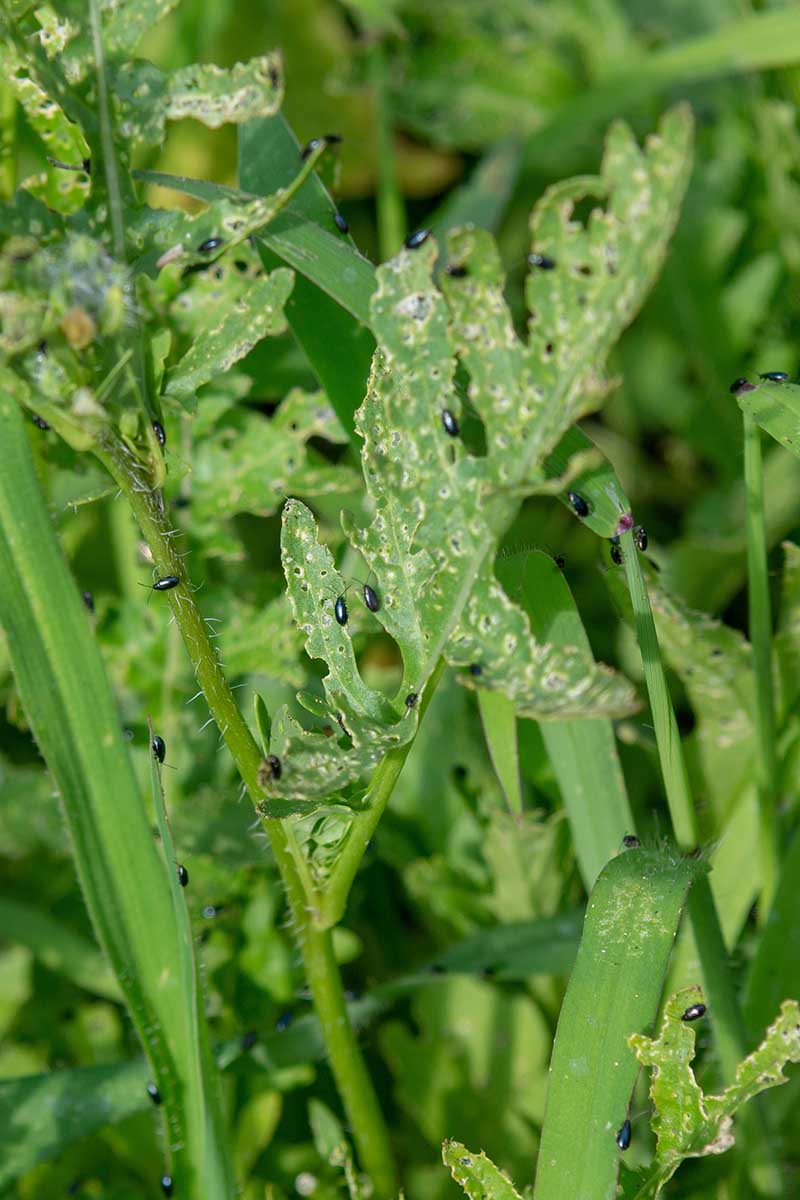
The striped flea beetle, P. striolata, measures one and a half to two and a half millimeters long. It’s black with yellow stripes.
Female adults lay white to yellowish eggs on the soil near the base of plants.
Flea beetles are challenging to address because they feed on roots below the surface of the soil in addition to visible foliage. And worst of all, they winter over in the ground or uncleared plant debris to return and wreak havoc the following year.
Organic approaches may prove effective, such as:
- Spraying the leaves with neem oil.
- Applying food-grade diatomaceous earth.
- Treating with Bt.
- Using a pyrethrin-containing product.
- Introducing beneficial predatory insects, like lacewings, parasitic nematodes, and parasitic wasps.
You’ll find more information on flea beetles in our guide.
8. Fungus Gnats
Fungus gnats, Bradysia spp. and Lycoriella spp. are not only found on houseplants.
If your vegetable garden is overcrowded, overwatered, and/or there is vegetable debris lying about, your arugula may suffer an infestation.
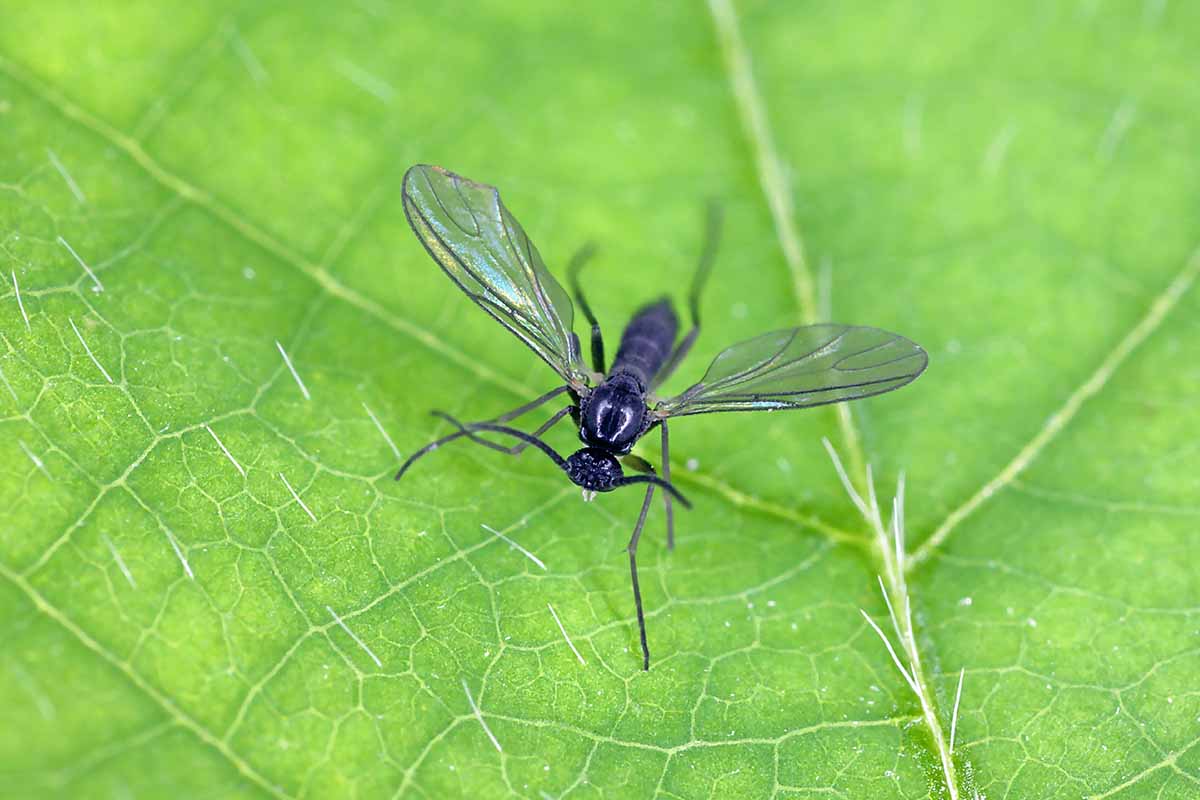
Tiny flying insects, fungus gnats are grayish-black with long antennae and legs. They measure two and a half millimeters long. However, the adults do no harm. It’s the larvae that do the damage.
The larvae are white with black heads and measure five and a half millimeters long. They feed on roots and soil debris. Young arugula plants are especially vulnerable to the root damage and stunted growth large populations can cause.
To prevent an outbreak, avoid overcrowding and overwatering your crops. To treat an existing infestation, address adults with sticky traps that help to curb mating and egg laying.
Add beneficial nematodes and Bacillus thuringiensis israelensis (Bti) to the soil to attack the larvae. Bti is a type of Bt especially effective on fly and mosquito larvae.
The Fungus Gnat Bundle combines all three modes of attack: the sticky traps, beneficial nematodes, and Bti, all in one convenient package.
Arbico Organics Fungus Gnat Control Bundle
The Fungus Gnat Control Bundle is available from Arbico Organics in half- and full-garden sizes.
See our article on how to control fungus gnats for more information.
9. Grasshoppers
Grasshoppers (Acrididae family), are related to crickets. Their eggs are a variety of colors, from white and yellow to brown and red.
Adults are brown, gold, green, or tan, and have antennae, chewing mouthparts, long legs for distance jumping, and wings. They measure one to seven centimeters long.
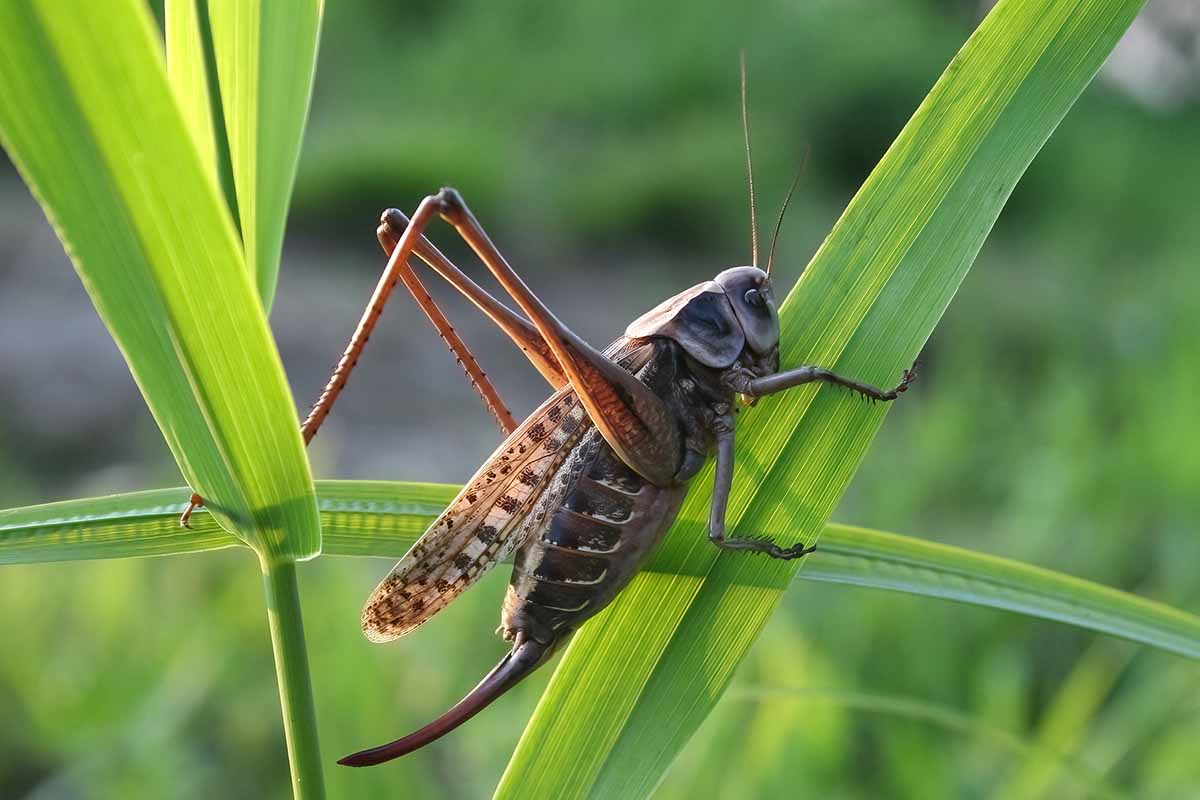
Grasshoppers prefer hot, dry conditions and lots of weedy growth for them to inhabit. Telltale signs of damage are large, irregular holes in arugula foliage.
Deter these ravenous feeders with the garlic-like odor of neem oil or a garlic barrier.
Garlic Barrier is a natural repellent suitable for edible crops. And although plants absorb it, the taste of the leaves is unaltered and they remain safe to eat.
Garlic Barrier is available from Arbico Organics in quart-bottles of concentrate for dilution with water before use.
In the case of a severe infestation, you may want to try Monterey Garden Insect Spray.
This product is a broad-spectrum, organic pesticide containing spinosad derived from Saccharopolyspora spinosa, a naturally-occurring soil bacterium toxic to a number of pests, including caterpillars, crickets, grasshoppers, leaf miners, and thrips.
Monterey Garden Insect Spray RTU is available from Arbico Organics in 32-ounce ready-to-spray bottles. Note that it is toxic to bees and aquatic invertebrates.
10. Leaf Miners
Leaf miners are the larvae of multiple beetle, fly, and moth species, including Coleoptera, Diptera, Hymenoptera, and Lepidoptera. They quite literally “mine” plant tissue, feeding on the juices.
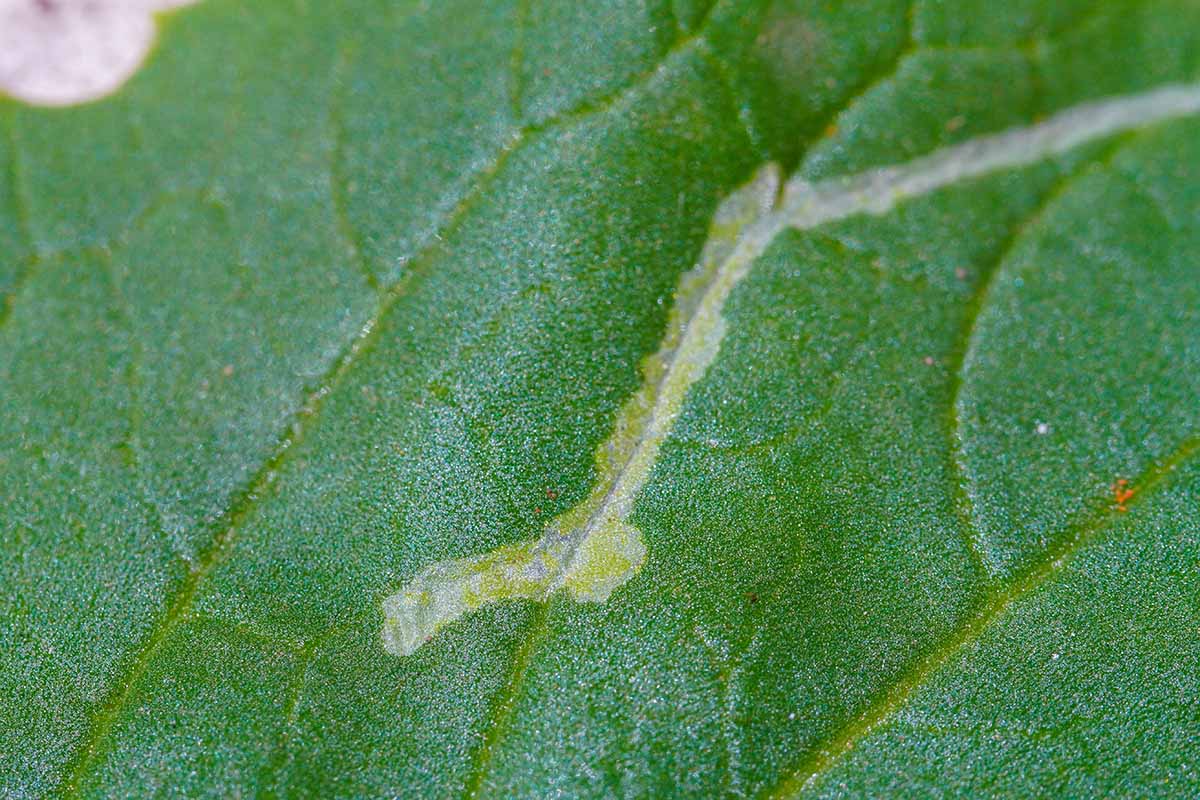
The adults of the various species lay white to translucent eggs that hatch out as white to yellow larvae.
They measure one to seven millimeters long and nourish themselves by tunneling through the foliage, leaving telltale white to tan patches and squiggly trails where they have sucked the plant tissue dry.
If you look closely, you may also see the tiny holes that mature larvae make when they chew through the foliage and fall to the ground, where they continue the maturation process as pupae.
Because leaf miners winter over as pupae (pre-adults), keeping the garden free of weeds and post-harvest plant debris is essential.
Before planting your arugula, turn the soil under, breaking up clods and disrupting any pupae living there.
Introduce flowering companion plants, like dill and yarrow, to attract beneficial insects that prey upon leaf miner larvae, like predatory wasps.
Use yellow or blue sticky traps to attract and capture adults and inhibit reproduction.
Foliar treatments are generally ineffective because the larvae burrow between the leaf surfaces.
Insecticide products containing broad-spectrum spinosad, mentioned above, may be effective, if applied just as the larvae are hatching.
Beneficial nematodes (Steinernema carpocapsae and S.feltiae) may address pupae in the soil.
See our guide for more information on addressing leaf miners.
11. Root-Knot Nematodes
Root-knot nematodes, Meloidogyne spp., are microscopic, parasitic soil-dwellers that feed on roots and destroy plants via physical damage and the diseases that penetrate the wounded root tissue. They are more prevalent in warm weather and in southern regions.
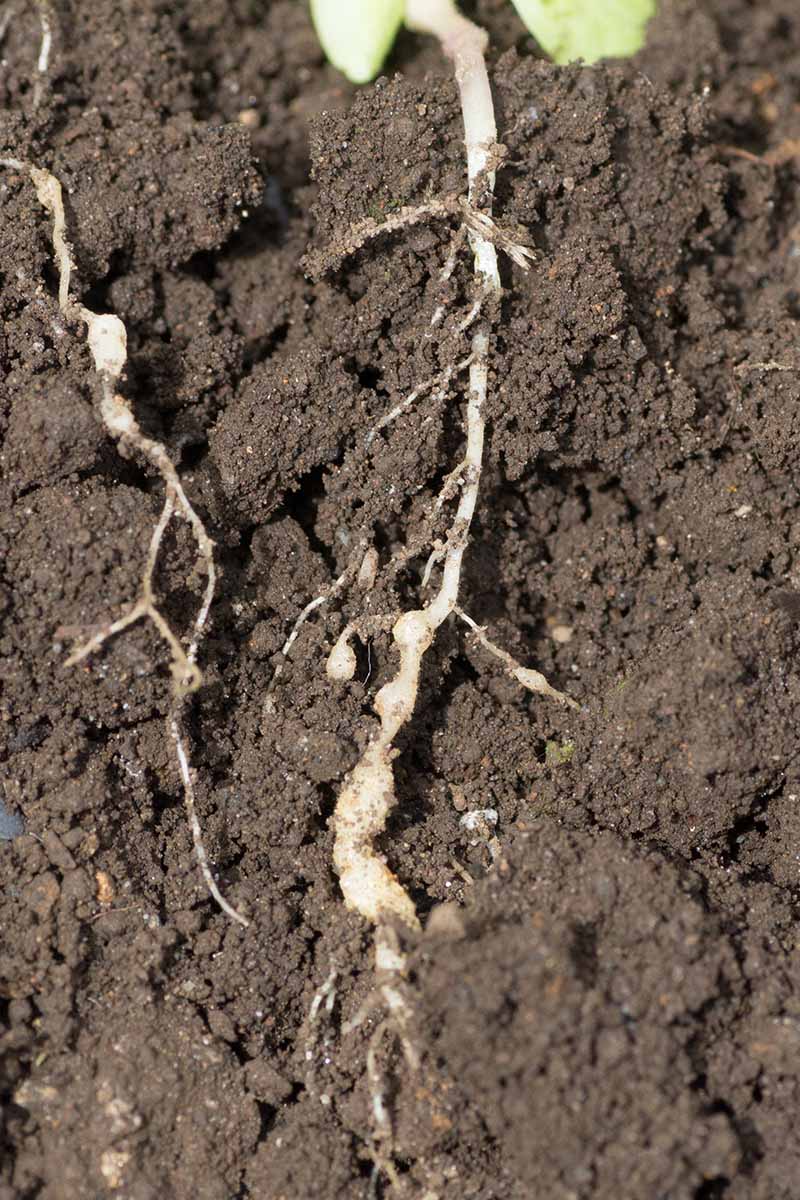
Adult females burrow into the roots of plants, where they lay eggs. The hatchlings feed on the roots, causing them to swell with disfiguring galls.
All of this takes place under the soil, making it impossible to notice until the damage is so advanced that the affected roots can no longer nourish the plants and they begin to fail, suffering from stunting and wilting.
The only way to make a specific diagnosis is to dig up your arugula and inspect the roots for damage. And unless you have a high-powered microscope, you’ll never see the culprits.
Proactive measures include sowing resistant seed varieties and maintaining healthy soil teeming with beneficial microbes.
You can improve your soil by adding beneficial nematodes to feed on the parasites.
Another option is to add “chitin,” a soil amendment and natural nematicide consisting of pulverized crustacean shells.
Neptune’s Harvest Crab and Lobster Shell
With a nitrogen-phosphorus-potassium (N-P-K) ratio of 5-3-0, plus added calcium and magnesium, the whole garden gets a nutritional boost as well as an organic nematicide treatment.
Neptune’s Harvest Crab and Lobster Shell is available from Arbico Organics in bags containing four, 12, and 44 pounds.
Read more in our guide to managing root-knot nematodes.
12. Salt-Marsh Caterpillars
The salt-marsh caterpillar, Estigmene acrea, is prevalent in warm, southern regions. Successive instars get bigger and bigger and achieve lengths of 45 to 55 millimeters.
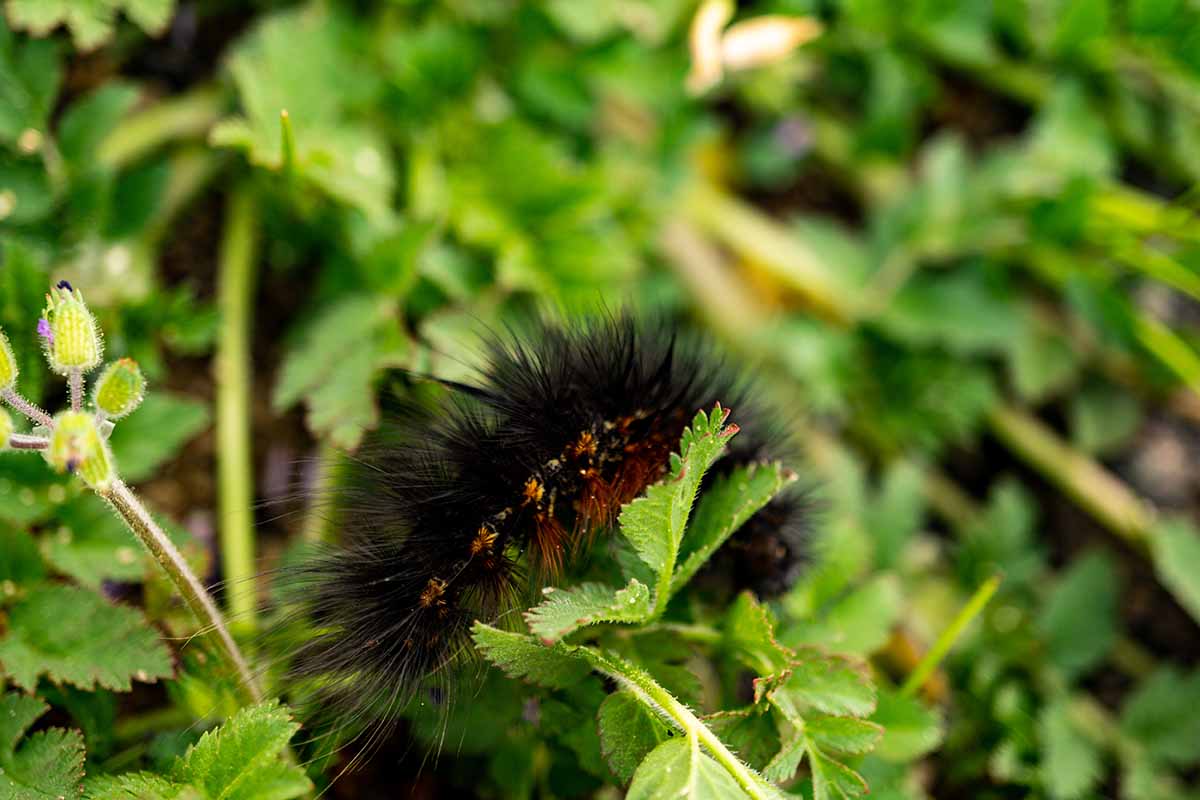
Adult moths have white wings with black spots and yellowish wing undersides and abdomens. Females lay yellow eggs on the undersides of leaves that shade to gray as they mature. Hatchlings feed as a group, skeletonizing the arugula leaves from below.
Young caterpillars are brown, cream, yellow, or white. Mature specimens are black with tufts of black, orange, and white hairs. At this stage, they feed individually, making holes in the foliage rather than defoliating entire leaves.
The hairs on their bodies can cause skin irritation and rashes, so take care if you observe these in your garden.
Tachinid flies are natural predators of salt-marsh caterpillars. If you plant aromatic flowering umbellifers or plants in the parsley family, like caraway, dill, and fennel, you can attract them.
Wear gloves to handpick the pests and destroy egg-encrusted foliage.
Bt may be effective in treating an outbreak.
13. Slugs and Snails
Snails and slugs are invertebrates known as gastropods. They feast on fresh, tender leaves and rotting foliage, and prefer cool, damp, dark conditions.
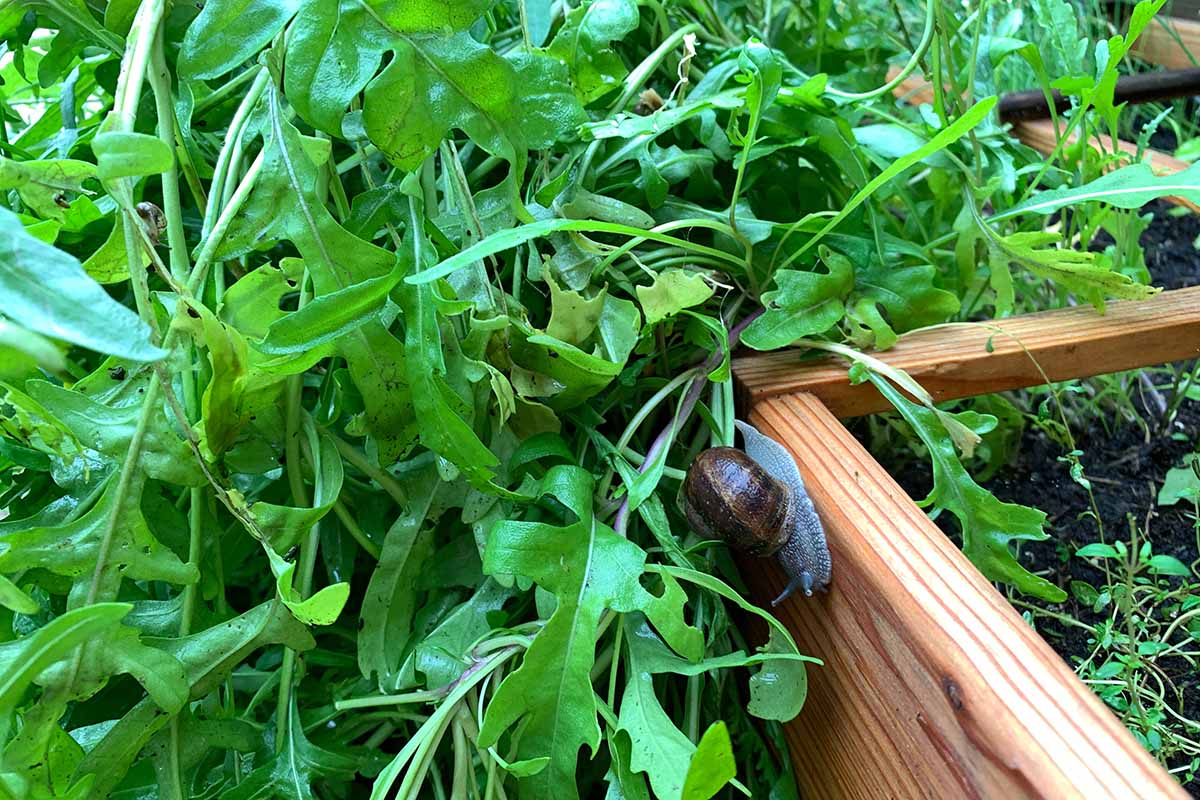
In addition to chewing irregular holes in the arugula leaves, they leave telltale slime trails.
Deter slugs and snails by spacing plants per mature dimensions to allow for ample airflow between them, and take care not to overwater.
You’ll find a variety of baits, barriers, and repellents on the market.
Dr. Earth Final Stop Snail & Slug Killer Spray is an organic product. It’s food-safe and contains essential oils, including cinnamon, garlic, peppermint, rosemary, sesame, and thyme.
Dr. Earth Final Stop Snail & Slug Killer Spray
Dr. Earth Final Stop Snail & Slug Killer Spray is available from Arbico Organics in 24-ounce ready-to-spray bottles.
You’ll find more information on slugs and snails in our guide.
14. Thrips
Thrips are sapsucking insects in the Thysanoptera order. Some are pests that drain foliage of its juices, leading to silvery discoloration, brown scarring, deformity, and stunting.
Winged adults are narrow, range in color from translucent white or yellowish to black, and measure up to two millimeters long.

The Western flower thrip, Frankliniella occidentalis, feeds on arugula.
The adult female embeds translucent white eggs in the foliage or deposits them on the surface. White or yellow nymphs hatch and feed before dropping onto the soil to pupate before emerging as adults.
As thrips feed, they leave a black “frass” trail on the foliage, another noticeable sign of infestation.
And when the growing season ends, they easily overwinter in plant debris.
Avoidance measures include:
- Growing your arugula under floating row covers.
- Laying reflective mulch around plants to make it hard to locate arugula host plants.
- Using pollen-rich flowering plants as trap crops.
- Clearing weeds and debris during and after the growing season.
To treat an infestation that is already underway, install blue sticky traps to catch the adults and inhibit reproduction. Blue is more effective at attracting thrips than yellow traps.
Arbico Organics Blue Insect Traps
Blue double-sided insect traps are available from Arbico Organics in packages of five, 10, 25, 50, and 100.
An application of neem oil may help to treat a full-blown infestation.
And finally, consider plantings that attract pirate bugs, lacewings, and ladybugs that prey upon thrips.
Cosmos are flowers that attract pirate bugs and lacewings.
To attract ladybugs, plant umbellifers like dill and fennel.
See our guide to managing thrips for more information.
15. Whiteflies
Whiteflies, from the Aleyrodidae family, are winged sapsuckers that measure one and a half millimeters long.
Symptoms of damage include silver and yellow discoloration, desiccation, wilting, and sticky honeydew on the surface of the foliage. When you jostle an infested leaf, adult flies rise in unison like a puff of white powder.

The females lay yellow eggs on the undersides of the leaves. The juveniles and adults infest the undersides of the leaves, feeding on the foliage.
Hot weather exacerbates infestations.
A proactive measure to deter whiteflies is to use reflective mulch to make it hard to locate your arugula.
The greatest challenge a whitefly infestation poses is that there are five life stages, and no one-size-fits-all treatment.
Spraying plants with the hose, removing and discarding affected leaves, and using yellow sticky traps may help reduce whitefly populations.
See our guide to managing whiteflies for more information.
Arugula Awareness and Action
Sow arugula seeds every few weeks throughout the growing season to enjoy multiple, abundant harvests.
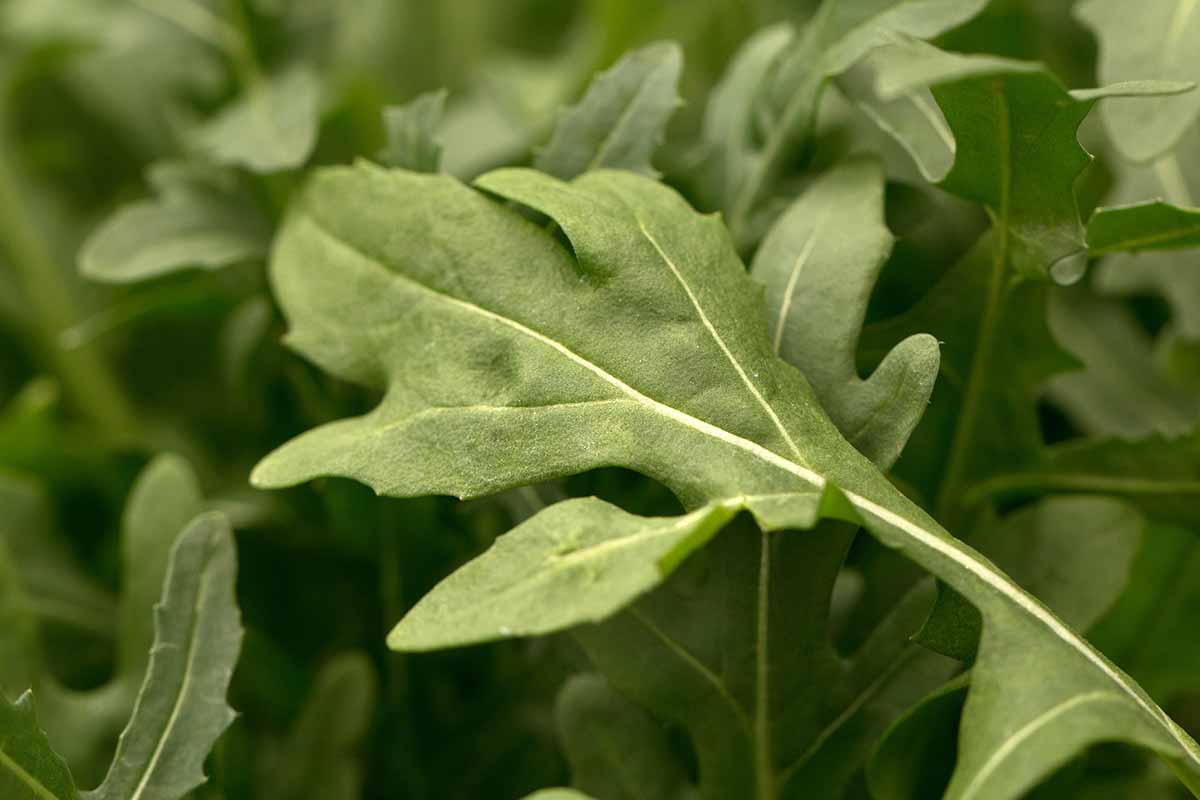
Read seed packets and space plants accordingly. Mature arugula needs 12 to 18 inches of space around it to reach full size. Skimping on space may increase the ambient humidity and create an environment conducive to moisture-loving pests.
Weed the garden regularly to deter insects further and promote airflow between plants.
Walk through the garden daily and look for irregular leaf margins, holes, deformity, and discoloration. Turn the leaves over and inspect the undersides.
When you become aware of pests, take immediate action.
Handpicking, spraying firmly with the hose, using floating row covers, sticky traps, and pinching off individual affected leaves may be all you need to head off an infestation.
When treatment is necessary, always use food-safe options, like Bt, food-grade diatomaceous earth, neem oil, spinosad, and pyrethrins. Read all product labels for safe and effective use.
Sanitize garden equipment, like tools and shoes, to avoid spreading pests and the diseases they may carry to other areas of the garden.
And finally, wash all of the arugula you harvest thoroughly before enjoying at your table.
Are you growing arugula? Have you had problems with pest infestations? Let us know in the comments section below!
And for more information about growing arugula in your veggie patch, have a read of these guides next:
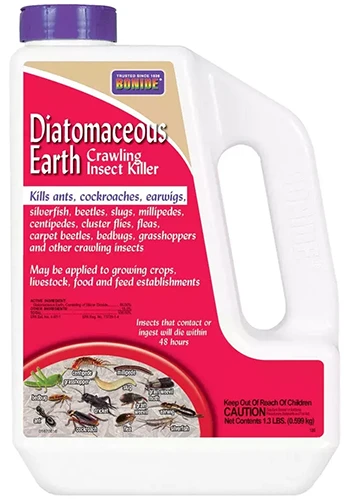


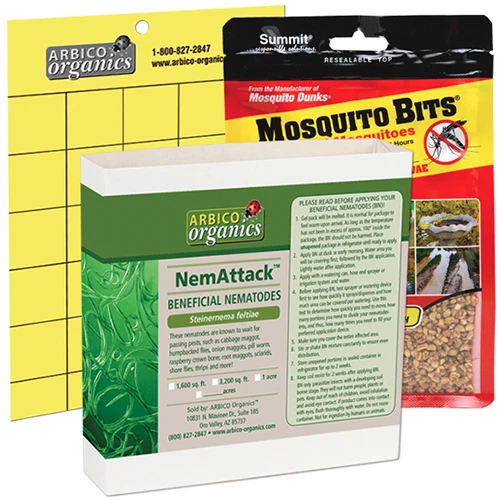
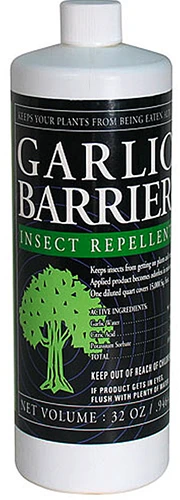
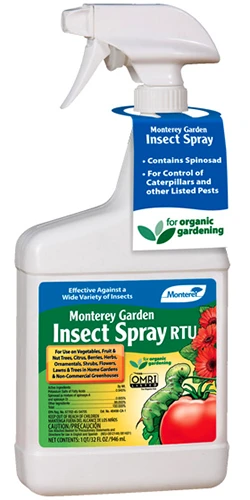

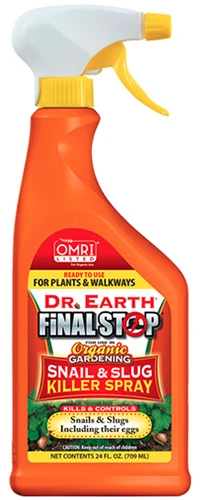

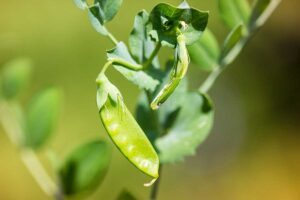


This is my first year with a real garden. My son build me a box 10′ x 3′ in January of 2023. In September I planted arugula. Man, oh man! Fresh from the garden tastes a thousand times better than from the grocery store in a bag. It was doing great for the last three months, but recently (December-January) it started having silver spots on the leaves. From your article, it seems like it is thrips. I’m wondering if it is because my basil is played out. I had variegated basil, and everything in my garden was thriving. I wasn’t… Read more »
Hi Corrine –
Research shows that basil is a “functional plant” that helps control aphid populations. Studies also demonstrate its effectiveness against thrips. You have indeed discovered a successful insect deterrent. Thank you for sharing!